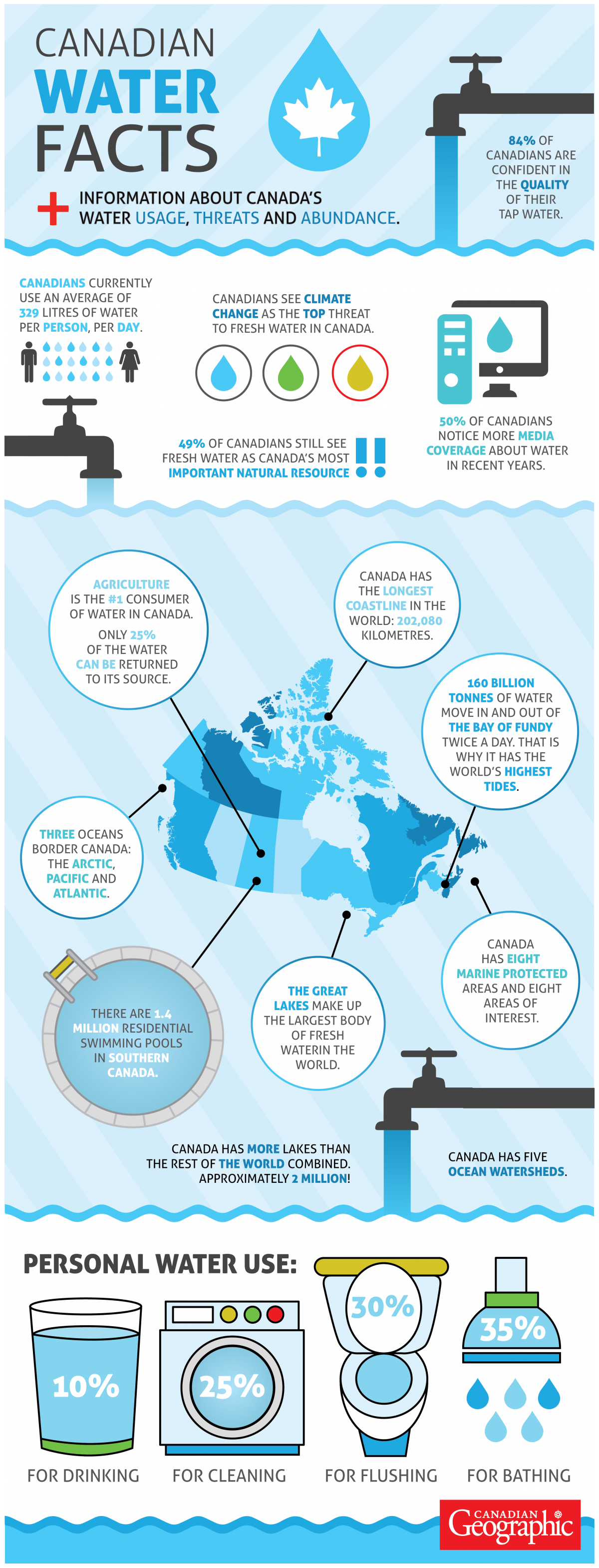How big is your water footprint?
The water we consume each day is more than just water from the tap. Knowing our "water footprint" can spark ideas to conserve this valuable resource.

Overview
Students investigate ways they use water on a daily basis. They’ll estimate their own daily water use (or "water footprint") and survey other students as well. Based on their findings, they’ll brainstorm ways to use less water at school and at home.
Instructions
What you'll need
- "The water we use" slideshow
- "Facts about water use" worksheet
- "What’s your water footprint?" worksheet
- "How much water do you use?" survey
- Chart paper and pens
- Digital projector and screen
Facts about water use
- As a class, discuss why it’s important to celebrate water here in B.C.
- Have students partner up and brainstorm ways they use water each day.
- Using the "The water we use" slideshow, show slides 1 to 9, then ask students to share other ways they use water.
- Present slides 10 to 16, pausing to let students guess the answer.
- Finish the slideshow and ask how we think it’s possible for Canadians to use 6,400 litres of water each day? How might this affect the environment? Share ideas as a class.
- Have students work in pairs to fill in the "Facts about water use" worksheet based on this infographic from Canadian Geographic:
 (Source: Canadian Geographic)
(Source: Canadian Geographic) - Bring the class back together to share their answers and listen to each other’s responses.
Water footprint
- Now it’s time to measure our "water footprints", or the amount of water we use in a day, using the "What’s your water footprint?" worksheet.
- Now we know our own water footprint, but what about the rest of the school? Let’s find out the average water footprint by pairing up and asking 10 other students the "How much water do you use?" survey questions during recess or lunch.
- With that data collected, each duo can fill out the "Student water footprint survey average" section.
- Share and compare the findings.
- Double up into groups of 4 and have students write down 10 water saving ideas.
- Display all the lists and give students time to check out all the great ideas.
- Time to take action – everyone picks one water saving idea and pledges to put it into practice.
Modify or extend this activity
- Ask students to survey their family members, then compare each other’s water footprints and think of ways to save water at home.
- Have students create posters that encourage others to reduce their water footprint and display them around the school.
- After a few weeks, check back in to see who was able to keep their water saving commitment.
Curriculum Fit
Our activities provide a link to the core competencies of the curriculum. The activities engage students in sharing information, working with others and presenting information. They challenge your students to consider their role in the world around them and how to make a difference.
Core competencies
Communication
- Connect and engage with others
- Acquire, interpret and present information
Thinking
- Creative thinking: generating and developing ideas
Social responsibility
- Contribute to community and caring for the environment
The activities also connect to a variety of grade-specific curricular competencies and content in a variety of subjects including Science, Social Studies and English Language Arts.
Assessments
- Assess students’ ability to communicate with others when working in pairs, as a small group and through class discussions.
- Assess students’ ability to accurately calculate their water footprint.
- Assess students’ ability to state ways they can reduce their water footprint.
Teaching Notes
BC Hydro’s Environmental responsibility
BC Hydro uses the power of falling water to create clean, reliable electricity. BC Hydro has become a leading sustainable energy company by producing and delivering electricity, in environmentally and socially responsible ways. Check out Environmental responsibility for ways BC Hydro is protecting and sharing the resource.
Young people can take action
Young people can act at school, in their community and at home to protect and care for water. We can empower them with a deeper understanding of how essential water is to life and encourage them to share this message to respect, protect and honour water.








